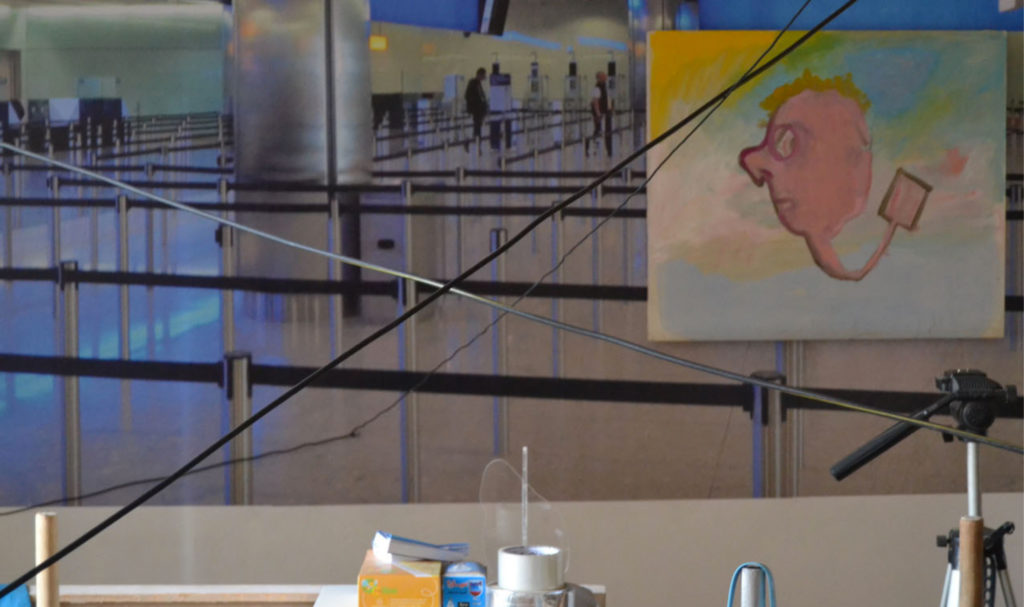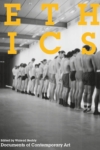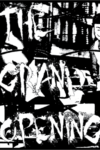
Art by Jenifer Evans (now Jasen Verefin)
This essay first appeared in the Full Stop Quarterly, Issue #7. To help us continue to pay our writers, please consider subscribing.
The fundamental emotion is sadness—the most painful feeling, and the hardest to comprehend,” the artist Bas Jan Ader once said to his friend Juliet Jacques. As recounted in her essay “i’m too sad to tell you about i’m too sad to tell you,” he continued: “People feel angry because they can’t understand their sadness—the way society shuns those who make it explicit means they have to repress it, and it becomes anger.” During the three-minute black-and-white film I’m Too Sad to Tell You, created by Bas Jan in 1971, a craggy male face rising from a black turtleneck descends directly into this fundament, crying gently into the camera for three straight minutes. The face, Bas’ own, sometimes tilts upwards so his tears glimmer in the stark low light, sometimes disappears briefly behind his hands swiping at his shaggy hair, and, in the last five seconds, contorts into the kind of tense sob that nearly mimics a grin. Juliet, the one pointing the camera at this now-infamous prefigurement of the crying selfie, told him: “You think you’re Christ.” His response: “I’m not dying for anyone! . . . I just make films.”
And so he did, for a while. In the most affecting of them, my favorites, rather than crying, he’s falling. The first of these, Fall I, Los Angeles, shows a wide shot of him sitting on the roof of his house on a wooden chair, leaning to the left until he topples over and tumbles down the shingles, the chair banging him in the back a few times before he lands in a bush. In Fall II, Amsterdam, in another wide shot he’s riding a bicycle down a path next to a canal, before suddenly swerving directly into the water. Both are very short (twenty-four and nineteen seconds, respectively) and slightly wry, like a screwball comedy without sound effects; both are shot in a single take and cut right after the fall is complete.
A year later, he made three more: Broken fall (organic), Broken fall (geometric), and Nightfall. He is dangling from a tree branch over a river, swaying in the breeze for what feels like a long time—about a minute and thirty seconds—delaying the inevitable confrontation with water, until finally falling to meet it (organic); or he is standing on a long walking path next to a wood stand, shrouded by plants on either side, a sole building rising boxy from the horizon behind him, slowly tilting his body to the left for what feels like a long time—a little more than a minute, again—before finally falling onto the wood stand (geometric); or he is, in his longest film, standing in the center of a garage at night, lit by two lightbulbs on the ground on either side of him, with a rock on the ground in the center. Over four minutes, he crouches down to pick up the rock, strains to lift it to his chest, and holds it for a beat before dropping it on the first of the lightbulbs; he repeats the process to break the second lightbulb. The film ends as soon as the rock crushes the last light.
These are all careful, almost innocuous, isolated gestures that hint at narrative without pursuing it. Like an iconic image zoomed in, or a candid reaction made into a GIF, Bas Jan’s films distill a singular emotional reaction, presented as neutrally as possible, clipped of context. We anticipate Bas Jan’s fall with a little flip of the stomach, like before a roller coaster plunge. Lingering in the moment right before a decisive movement downward, the verb I most associate with watching them is twinge; Rene Daalder must have felt similarly when he coined for this work the term “gravity art.”
Gravity is inevitable and impersonal, even if its consequences to one’s person are highly specific; in this way it resembles fate. A less-than-gentle irony, then, that Ader’s last, saddest artwork, to which he owes a large part of his posthumous infamy, was a performance both fatal and not filmed. From a tiny thirteen-foot bateau that could barely be called a boat, Bas set out to sail from Massachusetts to England in what he hoped would be “the smallest ship to ever cross the Atlantic,” propelled by the idea of an affective pilgrimage described thusly to Juliet: “Amidst the calmness of the ocean, without any distractions, my mind shall be focused purely on attacking the roots of human sadness, until it can only collapse and give way to pure happiness.” His boat was found nine months later off the coast of Ireland and was promptly stolen for scraps. He was never seen again.
•
It was during the epoch just before the 2016 presidential election that I first read the prickly, technocratic phrase “sentiment analysis”—though the concept itself has arguably been around since before Theophrastus invented taxonomy as a way to manage his obsession with plant life around 300 BC. Sometimes also called opinion mining or emotion AI, according to the first line of its Wikipedia page, sentiment analysis is technically, contemporarily, “the use of natural language processing, text analysis, computational linguistics, and biometrics to systematically identify, extract, quantify, and study affective states and subjective information.” Its use by nefarious actors like Cambridge Analytica during Brexit and the most recent US presidential election has been much publicized.
That politics have become increasingly, irrationally affect-laden in the last few years, and that the concept of rationality itself and its new whip, “data,” have become stapled in the noosphere to neoliberalism and the status quo, is now self-evident. A preoccupation with sentiment analysis is one way of explaining why, for instance, in the months since the election, I’ve been reading far more about and by people best categorized as my enemies than my interests or my friends, why the book I’ve spent the most time thinking of and rereading this year is a dense treatise primarily concerned with the inner lives and outre acts of marginalized men.
In the face of unintelligible disasters, feelings and hunches seem more reliable—the suspicion, for instance, that things cannot go on this way, and that old practices and institutions are failing to conform to new realities, says Mishra in Age of Anger, a snappy title and a broad feeling that is mostly winnowed in the book, in his globular and erudite style, into the precise term he prefers: ressentiment, as defined by Nietzsche and embodied by everyone from Bakunin to ISIS to Timothy McVeigh, an existential resentment of other people’s being, caused by an intense mix of envy and sense of humiliation and powerlessness. Because: Only on the rarest of occasions in recent decades has it been acknowledged that the history of modernization is largely one of carnage and bedlam rather than peaceful convergence, and that the politics of violence, hysteria and despair was by no means unique to Nazi Germany, Fascist Italy or Communist Russia . . . Jean-Jacques Rousseau, an indignant outsider in Parisian salons, had started to denounce modern commercial society for its moral corruption and inequality even before Adam Smith formulated the classically liberal and cosmopolitan vision of self-interested and competitive individuals and nations.
This Rousseauian emotional position, he argues, is more than an uncomely scurf on modernity’s skin—it sinks deeper, goes all the way down; ressentiment is our fundamental spiritual condition. And what exactly he means by our is one of his best ideas.
It is definitely not some esoteric Hadith that makes ISIS so eager today to adopt the modern West’s methods and technologies of war, revolution and propaganda—especially, as the homicidal dandyism of Jihadi John revealed, its media-friendly shock-and-awe violence, Mishra writes. The intellectual pedigree of today’s nasty atrocities is not to be found in religious scriptures. French colonialists in Algeria had used torture techniques originally deployed by the Nazis during their occupation of France (and also were some of the first hijackers of a civilian aeroplane). Americans in the global war on terror resorted to cruel interrogation methods that the Soviet Union had patented during the Cold War. In the latest stage of this gruesome reciprocity, the heirs of Zarqawi in ISIS dress their Western hostages in Guantanamo’s orange suits, and turn on their smartphone cameras, before beheading their victims.
The modern West can no longer be distinguished from its apparent enemies, he concludes, and he’s articulating a truth that extends far beyond terrorists. Enemies inside the West, which, he convincingly argues, is now a term that to a degree stakes the whole world, can no longer escape each other’s influences. If modernity’s primary mode of movement is mimesis, or the gruesome violence of reciprocity—a riff on Rene Girard’s idea of mimetic desire writ in ressentiment—then it’s a governing principle that’s entropic. It’s a motion made and made again, every surface a mirror, everywhere you care to look.
Turn your eyes, for instance, to ICE, who this April used the language of victimhood, developed and slowly legitimized in the mainstream by social justice movements over the last thirty years, to defend VOICE, Donald Trump’s absurd “emergency hotline” for “Victims of Immigration Crime Engagement,” from prank calls about UFOs: “this group’s cheap publicity stunt is beyond the pale of legitimate public discourse. Their actions seek to obstruct and do harm to crime victims; that’s objectively despicable regardless of one’s views on immigration policy . . . This group’s stunt is designed to harm victims. That is shameful.” (As pointed out in both Sara Ahmed’s 2004 book, The Cultural Politics of Emotion and Sarah Schulman’s recent Conflict is Not Abuse, “victimology” has become one of the most popular narrative identities on offer, regardless of one’s position relative to power.) On a right-wing website called Jacobite, Walter Scott enthusiast “Edward Waverly” chastised Chapo Trap House for poorly appropriating the energy and edge of alt-right content farmers; in a story that broke this May, an FBI employee fell in love with and married an ISIS leader in Syria—himself a former rapper from Germany—before “realising her mistake” a month in and returning to the United States to confess; in the New York Times, Molly Young compared the philosophy and products sold by Amanda Chantal Bacon, coastal elite juicer and “powerful influencer in the wellness space,” to Alex Jones’s InfoWars offerings, pointing out that subterranean paranoia answers to no single advertising demographic; in what a friend of mine claims will come to be known as “the definitive story of an era,” the craft store Hobby Lobby, owned by devout American Christians, probably funded ISIS; and all this is just a microdose of link detritus from around the time I started writing this.
•
Mishra: ‘Variety’, Tocqueville was already warning in the mid-nineteenth century, ‘is disappearing from within the human species; the same manner of acting, thinking, and feeling is found in all corners of the world . . . all peoples deal with each other more and copy each other more faithfully.’ Even those anti-imperialists who asserted their national personality and particularity against Europe’s rationalistic, aggressively universalizing missions actually ended up radically reconfiguring ancient religions and cultures such as Buddhism, Hinduism and Islam along European lines, infusing these modernized faiths with political purpose, reformist zeal and even revolutionary content.
•
There’s a perverse, pyrrhic prize in the fact that the surest sign of any new narrative’s success in culture is now its warped arrogation by corporate interests. When a logic from the margins is captivating enough that it becomes, for a critical mass of people, undeniable, it will be swallowed piecemeal instead, and emerge on the other end of the public stomach as a curvy Dove shampoo bottle; gruesome reciprocity, deployed by Mishra in relation to nationalist thinkers and terrorism beyond borders, applies far beyond merely-physical violence. What unites both modern subcultures and modern terrorists (and terrorist subcultures) is no coherent ideology but a set of shared affective responses to social chaos—and if the last decade of culture has any lesson to give, it’s that emotional tourism has never been more popular. I look forward to Pepsi’s first Pepe commercial. The cultural metabolism is getting faster and the narratives choppier as they’re chewed up.
•
Mishra: In many Western countries, what we term ‘radical Islamism’ has grown in tandem with a nativist radical right against the backdrop of economic decline, social fragmentation and disenchantment with electoral politics. Marginalized blue-collar Christians in Rust Belt America and post-communist Poland as well as long-bearded Muslims in France push a narrative of victimhood and heroic struggle between the faithful and the unfaithful, the authentic and the inauthentic. Their blogs, YouTube videos and social media incarnations mirror each other, down to the conspiracy theories about transnational Jews. The writings of Anders Behring Breivik, who killed nearly two hundred people in Norway in 2011, contained the same strictures against feminism as any Islamist screed. The German-Iranian teenager who killed nine people in Munich on the fifth anniversary of Breivik’s attack confirmed the mimetic nature of today’s violence by choosing a picture of Breivik as his WhatsApp profile.
•
The dicing of narrative is a phenomenon especially noticeable in the work of Jordan Wolfson, who, no accident, checks many of the same demographic boxes as Ader, and is one of his closest contemporary successors: an aggressive white male artist with an affinity for wry formalism over narrative coherence—or more appropriately, under it, the Latin bone in fundamental, fundus, being bottom—whose work swipes down to deliver intense, fragmented gestures stripped of the literacy and ethical valence of context. Where he departs from Ader is his thesis on the fons et origo of feeling, his lynchpin affect: The molten core in Wolfson’s world is a surging, palmed anger, or maybe a liminal lava between ressentiment and violence, swirling with cultural nightmares, all charged images and unstable symbols.
Wolfson is best known for his three most recent works, all of them expensive high-tech marriages of sculpture and performance art. (Female Figure), from 2014, is an animatronic robot-stripper with a pole through her abdomen, a dirty white dress, and a glossy witch mask. Facing a large mirror, while she dances and gyrates, while pop music plays and Wolfson’s voice recites non sequitur lines (“my mother is dead, my father is dead, I’m gay, I’d like to be a poet, this is my house”), she makes eye contact with her audience. If this all sounds a little kitsch, in person the experience is actually kind of selcouth. Meeting her plastic eyes, like I did at one of the sculpture’s permanent installations at The Broad in Los Angeles, is stridently uncanny, like witnessing a scuffed Hollywood fury greeting you at the entrance to Dis.
The two works that followed use violence more explicitly. In Colored sculpture, from 2016, a ghoulish, cartoonish boy doll—“kind of a hybrid of Huckleberry Finn and Alfred E. Newman and Howdy Doody”—is repeatedly strung up, flung around, and dropped to the ground by a set of chains. This I’ve only seen on YouTube. “Real Violence,” a two-minute VR film which premiered at the Whitney biennial this year, depicts a white man, first kneeling and then being beaten to death by a baseball bat wielded, to bloody effect, by the artist himself. This I’ve only read about.
In all three of these performance-sculptures, the fluttering stomach-flip of Ader’s melancholy gestures is amplified to dyspeptic gut-punch; as Wolfson himself once said in an interview on Colored sculpture, “it was about feeling more. Every decision I made in making this artwork, I didn’t ask myself intellectually, I asked myself intuitively and physically, what did I feel more for?”
Mishra: Many of these shocks of modernity were once absorbed by inherited social structures of family and community, and the state’s welfare cushions. Today’s individuals are directly exposed to them in an age of accelerating competition on uneven playing fields, where it is easy to feel that there is no such thing as either society or state, and that there is only a war of all against all . . .
. . . Moreover, the burden of personal inadequacy and estrangement that has been increased by the unavoidable awareness of an unlimited horizon of global complications: the information we have and are constantly stimulated by is much greater than the range of what we can do. The pressures on the human soul that Rousseau described could still be traced back to specific social conditions in Europe; and it was still possible, as he himself showed, to avoid the strain of loving oneself through others, and retreat from the social jungle into a clearing of one’s own. The German Romantics’ notion of self-cultivation suggested another way of deploying the human powers of understanding and feeling within precise boundaries.
But the experience of a sovereign life in a circumscribed place is much harder to achieve in the vast and complex space of the global, which is marked by currents, flows and waves rather than clear outlines or limits. In place of society or nature, the individual confronts a new indecipherable whole: the globe, in which multiple spaces and times bewilderingly overlap. Enmeshed in its various dense networks, including an electronic web mediating his relationship with reality, the individual can act satisfactorily neither upon himself nor upon the world, and is reminded frequently and humiliatingly of his limited everyday consciousness and meagre individual power.
Man, as Goethe wisely wrote in Wilhelm Meister’s Apprenticeship (1795), ‘is born to fit into a limited situation; he can understand simple, close and definite purposes, and he gets used to employing the means which are near at hand; but as soon as he goes any distance, he knows neither what he will nor what he should be doing.’
•
There’s something funereal in both Ader and Wolfson’s work. In this refusal of narrative cohesion, this wash of riptide emotions and fragmented images, there seems to me a regression that signals an end. This unravelling decline was described by Alain Badiou, in his The True Life, as “a profound idea explicitly expounded by Plato: When life is subject in this way to temporal immediacy, it falls apart by itself, dissipates, is no longer recognizable to itself, no longer tied to a stable meaning. Using Freudian and psychoanalytic terminology, which Plato often anticipated in many respects, we could say that this vision of life is one in which the life drive is secretly inhabited by the death drive. At an unconscious level, death takes hold of life, undermining it and detaching it from its potential meaning.”
And in this, it’s only appropriate that these mourners are those who have had the most to lose, and are losing it. It may also be true that both inhabit this “neutral” backslide because they are the only ones who can, by which I mean the only ones who are allowed. “The white body . . . has become an easy and lazy signifier for a universal body, for a metaphorical body, one that becomes symbolic and slippery, that can always be more than its mere representation,” wrote Ajay Kurja in an essay about Jordan Wolfson last year. “The non-white body, I believe, has greater difficulty in attaining this metaphorical bounty.”
This same complaint was raised in blunter terms during a Q&A with Wolfson at the New Museum this June, after he was asked about the idea of ‘white-on-white violence’ in “Real Violence.” On this term, he responded: “I’ve never really thought of specifically white-on-white violence . . . If I made the decision that a white guy beating a black guy, or if it was a black guy beating a white guy, suddenly the information in the artwork would be carried and transmitted, and then hypothetically would take the work to another type of narrative path that wasn’t part of my intention.”
An audience member, according to a Hyperallergic report, pressed him further: “Do you think about violence as a horizontal plane or hierarchy?”
“I’m not my art. I let the world pass through me, and then it takes a shape.”
This almost sounds like a line you might find in a book about meditation; a process rooted in Badiou’s temporal immediacy. The world that has emerged from this passage, of course, is not the whole world, merely the spectrum visible to him. But in his truculent work I see something true about a swatch of the world. Mishra argues that the demographic most susceptible to both terrorist violence and reactionary nationalism across the world is not the very poor, but the men of the middle classes, especially the lower middle class, starved for either success or authenticity and filled with resentment in the “war of all against all.” Most disaffected men don’t become terrorists, and they don’t become violence artists either; still, it’s not hard to imagine someone as extreme as Ader, willing to volunteer himself to a watery grave to “focus purely on attacking the roots of human sadness,” joining ISIS if life had occurred to him in a slightly different time and place.
Women, although not entirely absent from the repletion of writers, militants, and criminals referenced in Age of Anger—including the working-class French feminist Suzanne Voilquinn, anarchist and Marxist militant Anna Kuliscioff, and the infamous Russian assassin Sofia Perovskaya—are basically incidental, and he seems to consider any real analysis of gender in modernity as falling outside the scope of his project. Whiteness, deeply implicated in any discussion of “the West,” is never really brought into sharp focus either, although its casually racist “bland fanatics” are mocked at length, and its corrosive effects on the world since the industrial revolution is the book’s unifying gravity, its specific physics traced through dozens of different countries, violent revolutions, and depressed novelists.
“Terrorism excites identity, by concentrating it,” the neoreactionary Nick Land once wrote, “and packaging it in a false simplicity.” But peremptory identities power far more than detonating vests. Their false simplicity is an engine moiety to the exhaust of meaning, natant in the psychic miasma beneath the edifices of narrative or opinion, that is Wolfson’s entire project. Another mimesis.
•
Mishra: In many ways, figures like Zarqawi [famously the ‘shiek of slaughterers’ in Iraq] and Adnani [ISIS’ chief propagandist until his death last year] represent the death of traditional Islam rather than its resurrection.
•
If the invention of ISIS actually heralds the death of traditional Islam, then perhaps the ascendancy of identity politics has something similiar to say about individualism under neoliberalism; the commonplace, and therefore compromised, quest for individual distinction and singularity.
In an elegiac exhibition called At This Stage, on view this past July at Chateau Shatto in Los Angeles, one of Wolfson’s earliest videos is shown alongside a swath of mournful works, including a giant pile of tarnished American flags (Gardar Eide Einarsson’s Flag Waste (Stars and Stripes)), a single cotton branch embalmed in polyurethane and sheathed in a glass case like the rose in “Beauty and the Beast” (Aria Dean’s Dead Zone (I)), and a video of a simlike cartoon girl, drinking wine and playing an Elliot Smith song on a piano, inside an empty building filled with falling snow (Bunny Roger’s Mandy Piano Solo in Columbine Cafeteria). Wolfson’s work, “Con Leche” from 2009, depicts animated Diet Coke bottles, filled with milk, marching around scenes of gray urban decay in detroit. The walking bottles are accompanied by a voiceover of a woman reading internet comments on various subjects, including Buddhism, grief, and a man wondering why he doesn’t have any black friends; Wolfson interrupts her intermittently to issue orders about her vocal intonations with imperatives like “increase your volume” or “increase sex.”
The press release for the exhibition, which is just a series of bullet points, includes one that reads:
A question posed by maneul abreau: “how can we consider the power of these images when we’re already under their influence?” (I don’t know)
& another:
These questions announce themselves urgently and site-specifically in the United States, during a mass wading through conflicting currents, through the narratives that have been fattened, suppressed, squeezed out, swelled, merged, overlaid, edited, hacked
•
Mishra: History suddenly seems dizzyingly open-ended, just as Henry James experienced it when war broke out in 1914 and he confronted the possibility that the much-vaunted progress of the nineteenth century was a malign illusion—‘the tide that bore us along was all the while moving to this as its grand Niagara’.
•
In “Liberation Through Understanding In The Between,” also known as the Tibetan Book of the Dead, the life cycle is described in six “betweens”; the “death point” is a between state between “living” and “reality.” To finally die is to transition into revirescence; but to be dying is to hover dangerously on the precipice. In HBO’s recently wrapped The Leftovers, the world grapples with an enormous and unexplainable catastrophe, and loss of human life, with a resurgence of false saviors and a violent cult of death called “The Guilty Remnant.” They chainsmoke and terrorize their neighbors, “to remember.”
Juliet Jacques describes, in her sad essay, receiving a telegram from Bas Jan, nine months and two weeks before his Ocean Wave boat was found drifting off the coast of Ireland. It read: EMOTIONAL PATTERNS ESTABLISHED BEFORE CONSCIOUS MEMORY STOP SO THE FIRST STEP IS THE ONLY STEP STOP ACCEPTANCE OF SADNESS IS VICTORY OVER SADNESS STOP HUMANS LOOK FOR HAPPINESS WHEN THEY SHOULD BE SEEKING CONTENTMENT STOP THE MIRACULOUS HAS BEEN FOUND AND THE SEARCH CAN STOP
In “Con Leche” there’s this line, an internet comment the female voice recites, nearly-shrieks after being instructed to increase her volume: SOME PEOPLE WILL MOURN ONLY A SHORT TIME AND OTHERS FOR YEARS AND YEARS.
KV Luce is an occasional essayist in Los Angeles.
This post may contain affiliate links.







